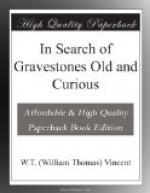Fig. 74.—At Wanstead.
“To William Bosely, died 1712, aged 79.”
[Illustration: Fig. 70. Barking.]
[Illustration: Fig. 71. Woolwich.]
[Illustration: Fig. 72. Deptford.]
[Illustration: Fig. 73. West Ham.]
[Illustration: Fig. 74. Wanstead.]
[Illustration: Fig. 75. Wanstead.]
There are several other variations of the same symbol in the elegant enclosure at Wanstead Church; but the most remarkable of the old stones is one which has at the top corners two projecting skulls, the one facing nearly to the front and the other in profile, both standing out in full relief, carefully and accurately sculptured, but too ghastly to be beautiful. This one, the Richmond example, and the two at Ripley constitute my entire experience of full relief work on a mere gravestone.
Fig. 75.—At Wanstead.
“To William Swan, died 1715, aged 16 years.”
Other churchyards in the locality we found less fruitful, and taking rail to Buckhurst Hill, we struck across Epping Forest to Chingford, also without profit, and walked on to Walthamstow, where another of the enfoliated death’s-head pictures was found; the novelty being two skulls with ivy sprays, symbolical of evergreen recollections.
Fig. 76.—At Walthamstow.
“To Jane Redfern, died 1734, aged 52 years,”
In the Broxbourne example on the same Plate (Fig. 77) branches of oak, bearing leaves and acorns, are used with good decorative effect on either side of a porch in which is seated a mourning figure, but I cannot undertake to explain the symbolical significance of the oak in sepulchral masonry.
Fig. 77.—At Broxbourne.
“To Mrs Rowe, widow, died 6 May 1798.”
My excursions into Essex have been too limited in scope to trace or test peculiarities in that county, but I have found by observation in a number of counties that, although there are occasional evidences of local invention, or at least of local modification, in certain districts, the same set of types which prevails in one county serves pretty well for all the rest.
It is well therefore to guard against disappointment. Pilgrimages like ours, having for their real purpose healthy exercise and physical enjoyment, are not to be counted failures when their ostensible errand seems to have borne no result. It is necessary for the pilgrim to be armed with some such reflection as this against the shafts of discomfiture. There have been occasions when, at the close of the day, conscious as I might be of the pleasant hours past, the freshened brain and the body reinvigorated, I have yet covetously mourned the scanty and valueless additions to my note-book. Other pilgrims may therefore take warning, be prepared




